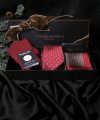The Mackintosh coat (or “Mac” for short) has been a wardrobe staple for nearly 200 years. The coat was originally developed in 1824 by its namesake, Scottish inventor Charles Macintosh. The original Mac was made from rubberized cloth created using a process patented by Mr. Macintosh (although some have alleged he stole the process from surgeon James Syme). Use of Macintosh’s innovative waterproof fabric quickly spread. His weather-proofed cloth was employed in the production of a variety of garments, particularly military and police gear. A testament to the timelessness of his creation, Mr. Macintosh’s company continues to live on today, albeit under the slightly modified Mackintosh (with a “k”) name.
The Macintosh Coat
The Mac’s original design was an exercise in utilitarian simplicity. It is single-breasted with a covered placket (e.g., hidden buttons) to prevent water coming in through the buttonholes. Unlike its close cousin the trench coat, a Mac has little in the way of embellishment. The buttons fasten from the wearer’ knee to the collar. The collar itself resembles a spread shirt collar and can be buttoned all the way up. The coat typically is cut below the knee to provide maximum coverage against the elements and has adjusters on the sleeve cuffs to allow one to tighten the opening securely around the wrist.
A classic Mac has a straight silhouette through the body and a long rear vent or pleat to allow for ease of walking. It can also come with standard sleeves set into the armhole at the natural shoulder, or it can have ‘Raglan sleeves’ that continue seamlessly over the shoulder and are secured at the collar. This style avoids a seam on the top of the shoulder that could allow water to seep in.
A shorter version of the Mac worn above the knee is referred to as a ‘car coat’. The car coat was popularized in the early days of the automobile when cars were open top or otherwise provided little protection against wind, rain and cold. The length of a traditional raincoat could impede the driver’s ability to work the peddles, so the coat was shorted, typically to mid-thigh.
While the styling of a Mac remains relatively unchanged, the technology used in waterproofing fabrics has seen dramatic improvement since Charles Macintosh and James Syme began experimenting with coal tar, turpentine and natural rubber. Today, mills such as Holland & Sherry and Loro Piana are developing increasingly advanced performance fabrics that are both functional and sophisticated. Holland & Sherry has a selection of traditional waterproof fabrics that use high-quality long staple cotton densely woven in a uniform manner to force the space between the yarns to close up, preventing the passage of water. The fabric is then infused with a water repellent treatment to enhance its weather resistance and increase performance.
Loro Piana has developed it proprietary Storm System fabrics using an innovative treatment that forms an invisible barrier around each fiber in the cloth. Storm System makes water droplets slide off the surface, enhancing a fabric’s impermeability and protecting it against dust, dirt and liquid stains. On the underside is a hydrophilic membrane resistant to both water and wind, which maintain an ideal body temperature. Unlike original raincoat fabrics, moisture from perspiration is wicked outwards, while external moisture is prevented from entering. Storm System can be used on a variety of natural fibers like wool, meaning raincoats no longer need to look like, well, raincoats.
While raincoats are generally intended to keep the wearer dry, they traditionally have done less to keep the wearer warm. This changed with the advent of removable linings, and with advances in insulating fabrics like Thinsulate, your raincoat can now do double-duty as an overcoat to keep you warm in colder months.
Trying to decided between the Mac and trench coat? As our friends over at Robb Report pointed out on the subject, “the winds of change blow unpredictably between the two. One season, Humphrey Bogart–style trenches are in; the next, the mac is the stormy staple of choice. The truth is neither is wrong, but this spring, attention does seem to be turning toward the mac. It’s cooler and cleaner—more Michael Caine in The Ipcress File than Peter Sellers in The Pink Panther.”
To get your own custom Mac coat, just give us a call. We’ll keep you dry in style.






